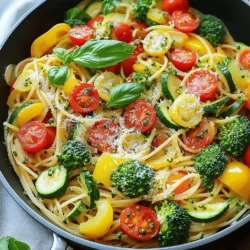
Pasta Primavera
Brighten up your dinner table with this delicious Colorful Pasta Primavera! Packed with vibrant veggies like bell peppers, zucchini, and cherry tomatoes, this dish is not only beautiful but also quick and easy to prepare. Perfect for a healthy weeknight meal or a delightful gathering. Follow our simple recipe and make it tonight! Click through to explore this colorful and nutritious dish that everyone will love!